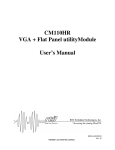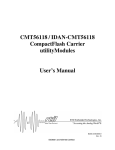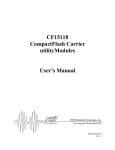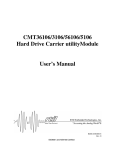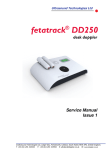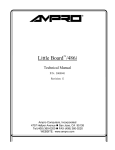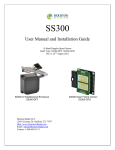Download CM17110 Super VGA + Flat Panel utilityModule User`s manual
Transcript
CM17110 Super VGA + Flat Panel utilityModule User’s manual & CM17120 Super VGA + DVI utilityModule User’s manual BDM-610020009 Rev. B ISO9001 and AS9100 Certified CM17110 Super VGA + Flat Panel & CM17120 Super VGA + /DVI User’s Manuals RTD Embedded Technologies, INC. 103 Innovation Blvd. State College, PA 16803-0906 Phone: +1-814-234-8087 FAX: +1-814-234-5218 E-mail [email protected] [email protected] web site http://www.rtd.com Revision history 2003.04.09. 2003.11.11 Initial release Added copyright notice (Rev B) Published by: RTD Embedded Technologies, Inc. 103 Innovation Blvd. State College, PA 16803-0906 Copyright 1999, 2002, 2003 by RTD Embedded Technologies, Inc. All rights reserved Printed in U.S.A. The RTD Logo is a registered trademark of RTD Embedded Technologies. cpuModule and utilityModule are trademarks of RTD Embedded Technologies. PhoenixPICO and PheonixPICO BIOS are trademarks of Phoenix Technologies Ltd. PS/2, PC/XT, PC/AT and IBM are trademarks of International Business Machines Inc. MS-DOS, Windows, Windows 95, Windows 98 and Windows NT are trademarks of Microsoft Corp. PC/104 is a registered trademark of PC/104 Consortium. All other trademarks appearing in this document are the property of their respective owners. Table of Contents CHAPTER 1. 1.1. 1.1. 1.2. FEATURES..........................................................................................................................2 RECOMMENDED CABLES ...................................................................................................3 GENERAL SPECIFICATIONS .................................................................................................3 CHAPTER 2. 1.3. 1.4. INTRODUCTION ..............................................................................................1 CONFIGURING THE CM17110/CM17120 UTILITY MODULES.............4 PCI BOARD SELECTOR (RSW1) .........................................................................................4 RECOMMENDED PROCEDURE .............................................................................................4 CHAPTER 3. CHAPTER 3 CONNECTING THE UTILITYMODULES (CM17110) .......5 3.1. FINDING PIN 1 ON THE CONNECTORS.................................................................................5 3.2. COMPONENT LOCATIONS ...................................................................................................5 3.3. CONNECTORS ....................................................................................................................6 3.4. FUSES ................................................................................................................................6 3.5. CONNECTOR PINOUTS ........................................................................................................7 3.6. FLAT PANEL POWER, CN4 ................................................................................................8 3.7. FLAT PANEL INTERFACE, CN3 ..........................................................................................9 3.8. FLAT PANEL INTERFACE EXTENSION, CN6 .....................................................................10 3.9. FLAT PANEL BIT CONFIGURATIONS ..................................................................................11 3.10. FLAT PANEL SIGNAL INFORMATION .............................................................................12 3.11. JUMPERS AND SWITCHES .............................................................................................12 CHAPTER 4. 4.1. 4.2. 4.3. 4.4. 4.5. 4.6. 4.7. 4.8. FINDING PIN 1 ON THE CONNECTORS...............................................................................14 COMPONENT LOCATIONS .................................................................................................14 CONNECTORS ..................................................................................................................15 FUSES ..............................................................................................................................15 CONNECTOR PINOUTS ......................................................................................................15 FLAT PANEL INTERFACE, CN3 ........................................................................................17 DVI FLAT PANEL INTERFACE, CN4 ................................................................................17 JUMPERS AND SWITCHES .................................................................................................17 CHAPTER 5. 5.1. 5.2. 5.3. SOFTWARE INSTALLATION .....................................................................21 SOFTWARE INSTALLATION...............................................................................................21 WINDOWS 98...............................................................................................................21 WINDOWS NT 4.0............................................................................................................24 WINDOWS 2000...............................................................................................................25 CONTROL PANEL APPLICATION .......................................................................................28 CHIPSVGA DOS UTILITY ................................................................................................29 CHAPTER 7. 7.1. USING THE UTILITYMODULES................................................................19 VGA ...............................................................................................................................19 CHIPS & TECHNOLOGIES DOCUMENTATION ....................................................................19 DRIVER DISK ...................................................................................................................20 CHAPTER 6. 6.1. 6.1.1. 6.2. 6.3. 6.4. 6.5. CONNECTING THE UTILITYMODULES (CM17120).............................14 FLASH BIOS PROGRAMMING...................................................................30 USAGE OF THE BIOSPROG.EXE:...................................................................................30 7.1.1. READ AND SAVE BIOS IMAGE TO DISK:.......................................................................30 7.2. REPROGRAM THE BIOS:..................................................................................................30 CHAPTER 8. TROUBLESHOOTING...................................................................................31 CHAPTER 9. FLAT PANEL CONNECTION EXAMPLE (CM17110 ONLY) ................32 9.1. 9.2. CABLE CONNECTION:.......................................................................................................32 PANEL SWITCHES:............................................................................................................33 CHAPTER 10. 10.1. 10.2. RETURN POLICY AND WARRANTY....................................................34 RETURN POLICY ..........................................................................................................34 LIMITED WARRANTY...................................................................................................35 Chapter 1. Introduction This manual gives information on the CM17110 and CM17120 Super VGA utilityModuless. This utilityModules and drivers provide support for additional features of your PC, such as greater speed, higher resolution, and more available colors. These modules support: Super VGA CRT interface and Flat panel interfaces. The CM17110 Super VGA + Flat Panel and CM17120 Super VGA + DVI utilityModules were designed to assist display to support RTD’s PC/104-Plus CPU modules and other standard PC/104-Plus processor modules. 1.1. Features The following are major features of the CM17110/CM17120 Super VGA utilityModules. • 32-bit Hardware graphics-accelerator • Linear memory addressing • Hardware cursor • Windows NT, Windows 2000 and Windows 95/98 drivers • Plug and play hardware configuration (PCI 2.1 compatible) • Embedded 4 Mbyte SDRAM memory • 83 MHz SDRAM operation • Integrated Clock Synthesizers • 170 MHz RAMDAC • 83 MHz Memory Clock with PLL • Dual Independent Display • Different or same image CRT and Flat Panel • Independent display timing and resolution for CRT and Flat Panel • HiQColorTM Technology implements TMED on STN displays: • up to 16.7 Million colors • Flash-Programmable User Video BIOS Super VGA CRT interface: • Single view resolution up to 1600x1200 pixels with 64K colors • Dual Independent Display Mode up to 1280x1024 with 256 color • Up to 16,7 million colors • Resolution support for: VGA, SVGA, XGA, SXGA, UXGA Advanced Flat-panel interface: (CM17110) • Support passive and active colors, monochrome, EL and plasma displays • Resolution up to 2048x1024 pixels • Up to 16 million colors • Power switching and sequencing • Variable bias voltage supply Standard DVI interface: (CM17120) • CM17110/CM17120 Resolution up to 2048x1024 pixels 2 RTD Embedded Technologies, Inc. • Supports DVI-A and DVI-D monitors Low power-consumption: • 2W typical from single (+5V power supply) Software Included: • Drivers for Windows 95/98, Windows NT 4.0 / 2000 / XP • Flash BIOS Programming Utility • BIOS version for Flat Panels Dual Multimedia Accelerator Engines • Color Space Conversion (YUV 422-RGB) • Horizontal and Vertical Interpolation • Double buffering support for YUV and 15/16 RGB • Color Key Video Overlay Standards Supported 1.1. • Fully IBM VGA Compatible • VESA DPMS and DDC1/2 • Advanced Power Management • ACPI Compliant Recommended Cables To allow maximum flexibility, cables are not included with the CM17110/CM17120. We offer a ready-made cable kit for the module, which may be purchased separately. CM17110/CM17120 uses cable kit XK-CM37, which contains: • 1.2. VGA monitor cable (DIL10 to DSUB15) General specifications • Dimensions: 96x96x24 mm including connectors Operating conditions CM17110/CM17120 • Temperature: -40 to +85 degrees C • Relative humidity: 0-95% non condensing • Storage temperature: -55 to +85 degrees C 3 RTD Embedded Technologies, Inc. Chapter 2. Configuring the CM17110/CM17120 utility Modules The following sections contain information on configuring the CM17110/CM17120 utilityModules. Please read the entire section before attempting to use the utilityModules! 1.3. PCI board selector (RSW1) Since the utilityModules uses stack through buses, the only hardware installation you will do is to place the module onto the PC/104-Plus stack. To do this, you will connect the ISA or PCI bus connectors. Before you can use this module you have to set the PCI board selector rotary switch located on the board (RSW1). If this module is the first from the CPU module select ’0’, if the second select ’1’, etc. 1.4. Recommended procedure We recommend you follow the procedure below to ensure the stacking of the modules does not damage connectors or electronics. • Turn off power to the PC/104-Plus system or stack. • Select and install standoffs to properly position the utilityModules on the PC/104-Plus stack. • Touch a grounded metal part of the stack to discharge any buildup of static electricity. • Remove the utilityModules from its anti-static bag. • Check to see if the keying pins in the PCI bus connector are properly positioned. • Check the stacking order and set the PCI selector rotary switch. • Hold the utilityModules by its edges and orient it so that the bus connector pins line up with the matching connector pins on the stack. • Gently and evenly press the utilityModules onto the PC/104Plus stack. CAUTION: Do not force the module onto the stack! Wiggling the module or applying too much force may damage it. If the module does not readily press into place, remove it, check for bent pins or out-of-place keying pins, and try again. CM17110/CM17120 4 RTD Embedded Technologies, Inc. Chapter 3. Chapter 3 Connecting the utilityModules (CM17110) The following sections describe connectors of the CM17110 Super VGA utilityModules. 3.1. Finding Pin 1 on the Connectors A square solder pad visible on the bottom of the PC board indicates pin 1 on the connectors. 3.2. Component locations The figure below shows locations of major components, including connectors. CM17110 CN16: PCI Bus CN12: SVGA Analog Connector JP1: BIOS Programming Jumpers SW1: Flat Panel Type Switches JP3: M or LP signals CN4: Flat Panel Power Connector TR1: CN18: Flat panel Connector Flat Panel Voltage Control JP2: +5V or +12V Back-light Supply CM17110/CM17120 CN1: XT Bus RSW1: PCI Rotary CN2: AT Bus Switch 5 RTD Embedded Technologies, Inc. 3.3. 3.4. Connectors Connector CN5 CN3 CN6 CN4 CN2, CN1 CN16 JP1 JP2 JP3 RSW1 Function SVGA analog output Flat panel output Flat panel extension Flat panel Power Connector AT/XT bus1 PCI bus BIOS programming jumper +5V or +12V backlight supply M or LP signals output PCI rotary switch Dimension 10 pin 40 pin 14 pin 12 pin 64+32 pin 120 pin 4 pin 3 pin 3 pin Rotary switch SW1 B1 TR1 Flat panel type switches VEE voltage select Flat panel voltage control 4 DIP switches Solder blob Trimmer Fuses Fuse F1 F2 F3 F4 F5 Value 2A 2A 1A 1A 1A Value and signal VBLKSW VDDSW -VEE +VEE +5V Connector CN18 (2) CN18 (1) CN18 (5) CN18 (3) CN12 (3) 1 Not used for the operation of the utilityModules. Used only to pass through ISA signals for other board on the stack. CM17110/CM17120 6 RTD Embedded Technologies, Inc. 3.5. Connector pinouts SVGA Video Connector, CN5 DIL Pin Signal Function 1 VSYNC Vertical sync 2 HSYNC Horizontal sync 3 DDC CLK Power supply 4 RED Red signal 5 DDC DATA Monitor detect 6 GREEN Green signal 7 +5V Clock 8 BLUE Blue signal 9 GND Ground 10 GND NC Ground No Connect DB15 Pin 14 13 15 1 12 2 9 3 5, 6, 7 10, 8 4, 11 Shown another way, the pinout of this connector (facing the pins) is: 1 3 5 7 9 VSYNC DDC CLK DDC DATA +5V GND HSYNC RED GREEN BLUE GND 2 4 6 8 10 Note: In our XK-CM37 cable kit, not all ground pins of the DB15 VGA connector are wired to the utilityModules. In a very few cases, a particular monitor will require all ground pins to be connected. In these case, it will be necessary to use a cable with all ground signals connected to the utilityModules. Note: High-resolution video uses very high-speed signals. For optimum video performance, you should use a short video cable between the module and VGA connector and provide a low-impedance ground between your system and the VGA connector CM17110/CM17120 7 RTD Embedded Technologies, Inc. 3.6. Flat Panel Power, CN4 CN4 is a 12-pin DIL connector, which provides power, and control signals which may be used when interfacing a Flat Panel display. The pinout of this connector: Flat Panel Power Connector (CN20) DIL Pin Signal Function 1 ENAVDD Enable Panel Vdd 2 ENABKL Enable Panel 3 ENAVEE Enable Panel Vee 4 GND Ground 5 +5Vdc Power supply 6 +5Vdc Power supply 7 GND Ground 8 9 10 11 12 GND +12Vdc -12Vdc GND GND Ground Power supply Power supply Ground Ground in/out out out out - Shown another way, the pinout of this connector (facing the pins) is: Note: 1 ENAVD ENABKL 2 3 ENAVEE GND 4 5 +5V +5V 6 7 GND GND 8 9 +12V -12V 10 11 GND GND 12 The +5V, +12V and –12V pins are connected to the PC/104Plus bus and power supply connector. These voltages are not generated on the utilityModules. CM17110/CM17120 8 RTD Embedded Technologies, Inc. 3.7. Flat Panel Interface, CN3 CN3 is a 40-pin DIL connector which provides signals to connect Flat Panel Displays. DIL Pin Flat Panel Interface Connector (CN3) Signal Function Note 1 VDDSW Switched Panel Vdd 2 VBKLSW Switched Backlight supply 1 3 Vee(+) Positive Panel Bias 2 4 Vee(-) Negative Panel Bias 2 5 ENABKL Backlight Enable signal 6 GND 7 M(Data Enable) Modulation clock 8 Blank*/DE Blank/Display enable 9 GND 10 LP (HSync) Latch pulse 11 FLM (VSync) First line marker 3 12 GND 13 SHFCLK 14 GND 15 PNL0 Panel 0 4 16 PNL1 Panel 1 4 17 PNL2 Panel 2 4 18 PNL3 Panel 3 4 19 PNL4 Panel 4 4 20 PNL5 Panel 5 4 21 PNL6 Panel 6 4 22 PNL7 Panel 7 4 23 PNL8 Panel 8 4 24 PNL9 Panel 9 4 25 PNL10 Panel 10 4 26 PNL11 Panel 11 4 27 PNL12 Panel 12 4 28 PNL13 Panel 13 4 29 PNL14 Panel 14 4 30 PNL15 Panel 15 4 31 GND 32 PNL16 Panel 16 4 33 PNL17 Panel 17 4 34 PNL18 Panel 18 4 35 PNL19 Panel 19 4 36 PNL20 Panel 20 4 37 PNL21 Panel 21 4 38 PNL22 Panel 22 4 39 PNL23 Panel 23 4 40 GND Shift clock Notes: 1. VBKLSW can provide switched +5Vdc or +12Vdc, as selected by jumper JP2. 2. The magnitude of bias voltages Vee(+) and Vee(-) are adjusted by trimpot TR1 3. The Blank*/DE pin may be connected to either M or LP signals from the VGA controller by positioning jumper JP3 4. Flat panel RGB bit numbering please refer to Chips&Tech datasheet CM17110/CM17120 9 RTD Embedded Technologies, Inc. 3.8. Flat Panel Interface Extension, CN6 CN6 is a 14-pin DIL connector which provides additional signals to connect Flat Panel Displays. DIL Pin 1 2 3 4 5 6 7 8 9 10 11 12 13 14 CM17110/CM17120 Flat Panel Interface Extension Connector (CN19) Signal Function GND PNL24 Panel 24 PNL25 Panel 25 PNL26 Panel 26 PNL27 Panel 27 PNL28 Panel 28 PNL29 Panel 29 PNL30 Panel 30 PNL31 Panel 31 PNL32 Panel 32 PNL33 Panel 33 PNL34 Panel 34 PNL35 Panel 35 GND 10 Note 4 4 4 4 4 4 4 4 4 4 4 4 RTD Embedded Technologies, Inc. Mono Mono Mono Color Color Color Color Color Color Color Color Color SS DD DD TFT TFT TFT TFT-HR STN-SS STN-SS STN-DD STN-DD STN-DD 8 bit 8 bit 16 bit 9/12/16 bit 18/24 bit 36 bit 18/24 bit 8 bit 4 bP 16 bit 4 bP 8 bit 4 bP 16 bit 4 bP 24 bit Flat panel bit configurations Panel bit number 3.9. UD3 UD7 UR1 UR0 UR0 PNL0 D0 B0 B0 FB0 FB0 R1 R1 PNL1 D1 UD2 UD6 B1 B1 FB1 FB1 B1 G1 UG1 UG0 UG0 PNL2 D2 UD1 UD5 B2 B2 FB2 FB2 G2 B1 UB1 UB0 UB0 PNL3 D3 UD0 UD4 B3 B3 FB3 FB3 R3 R2 UR2 UR1 LR0 PNL4 D4 LD3 UD3 B4 B4 FB4 SB0 B3 G2 LR1 LR0 LG0 PNL5 D5 LD2 UD2 G0 B5 FB5 SB1 G4 B2 LG1 LG0 LB0 PNL6 D6 LD1 UD1 G1 B6 SB0 SB2 R5 R3 LB1 LB0 UR1 PNL7 D7 LD0 UD0 G2 B7 SB1 SB3 B6 G3 LR2 LR1 UG1 PNL8 LD7 G3 G0 SB2 FG0 B3 UG1 UB1 PNL9 LD6 G4 G1 SB3 FG1 R4 UB1 LR1 PNL10 LD5 G5 G2 SB4 FG2 G4 UR2 LG1 PNL11 LD4 R0 G3 SB5 FG3 B4 UG2 LB1 PNL12 LD3 R1 G4 FG0 SG0 R5 LG1 UR2 PNL13 LD2 R2 G5 FG1 SG1 G5 LB1 UG2 PNL14 LD1 R3 G6 FG2 SG2 B5 LR2 UB2 PNL15 LD0 R4 G7 FG3 SG3 R6 LG2 LR2 PNL16 R0 FG4 FR0 LG2 PNL17 R1 FG5 FR1 LB2 PNL18 R2 SG0 FR2 UR3 PNL19 R3 SG1 FR3 UG3 PNL20 R4 SG2 SR0 UB3 PNL21 R5 SG3 SR1 LR3 PNL22 R6 SG4 SR2 LG3 PNL23 R7 SG5 SR3 LB3 PNL24 FR0 PNL25 FR1 PNL26 FR2 PNL27 FR3 PNL28 FR4 PNL29 FR5 PNL30 SR0 PNL31 SR1 PNL32 SR2 PNL33 SR3 CM17110/CM17120 11 RTD Embedded Technologies, Inc. PNL34 SR4 PNL35 SR5 Pixels/ 8 8 16 1 1 2 2 2-2/3 5-1/3 2-2/3 5-1/3 8 Clock Note: R=red, G=green, B=blue, U=upper, L=lower, F=first, S=second 3.10. Flat panel signal information The following diagram shows the flat panel interface synchronization signals. LP (HSync) CN20 pin 10 M (Data Enable) CN20 pin 7 One line FLM (VSync) CN20 pin 11 One picture 3.11. Jumpers and Switches JP1 Pin 1-2 3-4 Description User VGA BIOS* Factory BIOS (32KB) JP2 Pin 1-2 2-3 Description Back light supply +12Vdc* Back light supply +5Vdc JP3 (Blank/Display enable select) Pin 1-2 2-3 * Description M signal from the VGA controller CN3 pin 8 connected to pin 7* LP signal from the VGA controller CN3 pin 8 connected to pin 10 Factory default CM17110/CM17120 12 RTD Embedded Technologies, Inc. SW1 # 4 1 ON 2 ON 3 ON 4 ON 5 ON 6 ON 7 ON 8 ON 9* OFF 10* OFF 11* OFF 3 ON ON ON ON OFF OFF OFF OFF ON ON ON 2 ON ON OFF OFF ON ON OFF OFF ON ON OFF 1 ON OFF ON OFF ON OFF ON OFF ON OFF ON Flat panel type description 1024x768 Dual Scan STN Color 1280x1024 TFT Color 640x480 Dual Scan STN Color 800x600 Dual Scan STN Color 640x480 Sharp TFT Color 640x480 18-Bit TFT Color 1024x768 TFT Color 800x600 TFT Color 800x600 TFT Color 800x600 TFT Color 800x600Dual Scan STN Color 12* OFF ON OFF OFF 13* OFF OFF ON ON 14* OFF OFF ON OFF 15* OFF OFF OFF ON 16* OFF OFF OFF OFF * Available only in large BIOS (>32K) 800x600Dual Scan STN Color 1024x768 TFT Color 1280x1024 Dual Scan STN Color 1024x600 Dual Scan STN Color 1024x600 TFT Color DIP switch SW1 layout: (all switch in OFF position) SW1 4 3 2 1 ON CM17110/CM17120 13 OFF RTD Embedded Technologies, Inc. Chapter 4. Connecting the utilityModules (CM17120) The following sections describe connectors of the CM17120 Super VGA utilityModules. 4.1. Finding Pin 1 on the Connectors A square solder pad visible on the bottom of the PC board indicates pin 1 on the connectors. 4.2. Component locations The figure below shows locations of major components, including connectors. CM17120 CN16: PCI Bus CN5: SVGA Connector SW1: Flat Panel Type Switches JP7: M or LP signals JP1: BIOS Programming Jumpers CN4: DVI Connector CN3: DVI DIL Connector JP2: DVI Output Settings CN1: XT Bus RSW1: PCI Rotary Switch CM17110/CM17120 14 CN2: AT Bus RTD Embedded Technologies, Inc. 4.3. Connectors Connector CN5 CN4 CN3 CN2, CN1 CN16 JP1 JP2 RSW1 SW1 4.4. Function SVGA analog output Standard DVI Flat panel output DVI Flat panel AT/XT bus2 PCI bus BIOS programming jumper DVI output configuration jumper PCI rotary switch Flat panel type switches Fuses Fuse F1 4.5. Dimension 10 pin 24+5 pin 20 pin 64+32 pin 120 pin 4 pin 16 pin Rotary switch 4 DIP switches Value Value and signal 1A +5V Connector pinouts VGA Video Connector, CN5 DIL Pin 1 2 3 4 5 6 7 Signal VSYNC HSYNC DDC CLK RED DDC DATA GREEN +5V Function Vertical sync Horizontal sync Power supply Red signal Monitor detect Green signal Clock DB15 Pin 14 13 15 1 12 2 9 8 9 10 - BLUE GND GND NC Blue signal Ground Ground No Connect 3 5, 6, 7 10, 8 4,11 Shown another way, the pinout of this connector (facing the pins) is: 2 Not used for the operation of the utilityModules. Used only to pass through ISA signals for other board on the stack. CM17110/CM17120 15 RTD Embedded Technologies, Inc. 1 VSYNC HSYNC 2 3 5 7 9 DDC CLK DDC DATA +5V GND RED GREEN BLUE GND 4 6 8 10 Note: In our XK-CM37 cable kit, not all ground pins of the DB15 VGA connector are wired to the utilityModules. In a very few cases, a particular monitor will require all ground pins to be connected. In these case, it will be necessary to use a cable with all ground signals connected to the utilityModules. Note: High-resolution video uses very high-speed signals. For optimum video performance, you should use a short video cable between the module and VGA connector and provide a low-impedance ground between your system and the VGA connector CM17110/CM17120 16 RTD Embedded Technologies, Inc. 4.6. Flat Panel Interface, CN3 CN3 is a 20-pin DIL connector, which provides signals to connect Flat Panel Displays. 1 3 5 7 9 11 13 15 17 19 4.7. DDC Data-DVI No Connect T.M.D.S. Clock+ T.M.D.S. Clock Shi ld +5V-DVI T.M.D.S. Data2+ T.M.D.S. Data2 Shi ld Data1+ T.M.D.S. T.M.D.S. Data1 Shi ld Data0+ T.M.D.S. DDC Clock-DVI Ground T.M.D.S. ClockGround (for + 5V) Ground T.M.D.S. Data2Ground T.M.D.S. Data1T.M.D.S. Data0 Shi ld Data0T.M.D.S. 2 4 6 8 10 12 14 16 18 20 DVI Flat Panel Interface, CN4 CN4 is a DVI standard connector to DVI compatible Flat Panel Displays. Pin 1 2 3 4 5 6 Signal Assigment T.M.D.S. Data2T.M.D.S. Data2+ T.M.D.S. Data2 Shield No Connect No Connect DDC Clock Pin 9 10 11 12 13 14 7 DDC Data 8 Analog Vertical Sync C1 Analog Red 15 16 C2 C4 Analog Horizontal Sync C5 4.8. Signal Assigment Pin T.M.D.S. Data117 T.M.D.S. Data1+ 18 T.M.D.S. Data1 Shield 19 No Connect 20 No Connect 21 +5V Power 22 Ground (return for +5V, HSync and VSync) 23 No Connect 24 Analog Green C3 Analog Ground (analog R,G & B return) Signal Assigment T.M.D.S. Data0T.M.D.S. Data0+ T.M.D.S. Data0 Shield No Connect No Connect T.M.D.S. Clock Shield T.M.D.S. Clock+ T.M.D.S. ClockAnalog Blue Jumpers and Switches JP1 CM17110/CM17120 Pin 1-2 Description User VGA BIOS* 3-4 Factory BIOS (32KB) 17 RTD Embedded Technologies, Inc. JP2 (DVI output settings) Pin A3,A2,A1* Low DKEN* High ISEL* Low Jumper Description 1-2 = Low These inputs are used to select the de-skewing setting for the input bus. 2-3 = High 1-2 = Low A3, A2, A1 is used as the de-skewing setting. The de-skewing increments are 260psec. 2-3 = High Default de-skewing is used 1-2 = Low I2C interface is inactive 2-3 = High I2C interface is active BSEL* 1-2 = Low 12-bit input mode High 2-3 = High 24-bit input mode DSEL* Low 1-2 = Low Single edge mode. Falling edge of the IDCK+ clock is used to latch data. 2-3 = High Dual edge mode EDGE* 1-2 = Low Low 2-3 = High PD 1-2 = Low DVI Output power down. Open 2-3 = High Normal operation * User should not change this setting SW1 # 4 2 ON 6 ON 7 8 ON ON 3 ON OFF 2 ON ON 1 OFF OFF Flat panel type description 1280x1024 640x480 OFF OFF ON OFF OFF OFF 1024x768 800x600 DIP switch SW1 layout: (all switch in OFF position) SW1 4 3 2 1 ON CM17110/CM17120 18 OFF RTD Embedded Technologies, Inc. Chapter 5. Using the utilityModules 5.1. VGA The video interface of the CM17110/CM17120 Super VGA utilityModules appears as a standard Super VGA card. It will support interlaced and non-interlaced analog RGB VGA monitors, but does not support digital RGB monitors. The module support the following general video modes: • Super VGA • VGA • XGA • SXGA • UXG • Quarter VGA 320x240, 320x200 • Monochrome For a complete list of supported video modes, please refer to the Chips and Technologies 69030 datasheet. (See the following section.) 5.2. Chips & Technologies Documentation Due to the complexity of the Chips & Technologies 69030 VGA controller chip, it is impossible for us to reproduce all programming information in this manual. If you will be doing in-depth programming of the VGA controller, we suggest you obtain the 69030 datasheet from the manufacturer. The 69030 datasheet is available on-line in electronic format as an Adobe Acrobat (.PDF) file on the Asiliant Technologies website. www.asiliant.com CM17110/CM17120 19 RTD Embedded Technologies, Inc. 5.3. Driver Disk The driver disk included with the CM17110/CM17120 Super VGA utilityModules contains drivers for. • Windows 95/98 • Windows NT 4.0 • Windows 2000 • Windows XP Although the CM17110/CM17120 Super VGA utilityModules are compatible with generic windows VGA drivers, the supplied drivers will provide optimal performance. CM17110/CM17120 20 RTD Embedded Technologies, Inc. Chapter 6. Software installation This chapter contains information on: 6.1. • Software installation • Control panel application Software installation 6.1.1. Windows 98 1. Select 'Control Panel' in Start/Settings 2. Select 'System' CM17110/CM17120 21 RTD Embedded Technologies, Inc. 3. Select 'Device Manager' tab and select the VGA adapter 4. Click Properties 5. Click 'Update Driver..." 6. Click 'Next' CM17110/CM17120 22 RTD Embedded Technologies, Inc. 7. Select 'Search....' and click 'Next' 8. Select 'Specify location', select the Windows 98 driver folder and click 'Next' 9. Click 'Next' 10. Click 'Finish' 11. Click 'Yes' to restart the computer CM17110/CM17120 23 RTD Embedded Technologies, Inc. 6.2. Windows NT 4.0 1. Start 'Display' in Control Panel, select 'Settings' tab 2. Click 'Change' 3. Click 'Have Disk...' 4. Set Windows NT 4.0 drivers folder, and click 'OK' CM17110/CM17120 24 RTD Embedded Technologies, Inc. 5. Click 'OK' 6. Click 'OK' 7. Click 'Yes' 8. Close display properties 9. Click 'Yes' to restart the computer 6.3. Windows 2000 1. Select 'Control Panel' in Start/Settings CM17110/CM17120 25 RTD Embedded Technologies, Inc. 2. Select 'System' 3. Click 'Device Manager...' button 4. Select 'Video controller...' and select device properties (right mouse button) CM17110/CM17120 26 RTD Embedded Technologies, Inc. 5. Click 'Reinstall driver...' 6. Click 'Next' 7. Select 'Search for...' and click 'Next' 8. Select 'Specify location' and click 'Next' CM17110/CM17120 27 RTD Embedded Technologies, Inc. 9. Specify the Windows 2000 driver location and click 'OK' 10. Click 'Next' 11 Click 'Finish' 12 Click 'Close', close device manager, close Control Panel and restart the computer 6.4. Control Panel application In control panel application you can select screen resolution, CRT and Flat Panel operation mode. This application available only in Windows platform. CM17110/CM17120 28 RTD Embedded Technologies, Inc. Set screen resolution: CRT and Flat Panel operation mode: 6.5. ChipsVGA DOS utility ChipsVGA utility can set CRT and Flat Panel operation mode in DOS. Available modes: CM17110/CM17120 • CRT CRT only mode, VDDSW off chipsvga.exe crt • LCD LCD only mode, CRT sync off chipsvga.exe lcd • BOTH both LCD and CRT are active chipsvga.exe both 29 RTD Embedded Technologies, Inc. Chapter 7. Flash BIOS programming The CM17110/CM17120 card supports in-circuit flash BIOS reprogramming through VGA chip, the reprogramming algorithm uses only the PCI bus. WARNING: do not reset or switch off the computer while programming in progress! You can use BIOSPROG.EXE program to reprogram the flash BIOS. 7.1. Usage of the BIOSPROG.EXE: BIOSPROG.EXE is a DOS-DPMI32 program. You have to use MS-DOS 6.22 or compatible dos with himem.sys. 7.1.1. Read and save BIOS image to disk: 1. Start BIOSPROG.EXE with a filename to save BIOS image to disk: A:\BIOSPROG.EXE oldbios.dat 7.2.Reprogram the BIOS: 1. Start BIOSPROG.EXE with two filenames: A:\BIOSPROG.EXE newbios.dat oldbios.dat 2. BIOSPROG.EXE search CM17110/CM17120 in the PCI bus 3. BIOSPROG.EXE saves current BIOS to oldbios.dat 4. when BIOSPROG.EXE prompt, put JP1 WE jumper on the board 5. BIOSPROG.EXE reprogram the flash BIOS (displays dot characters while programming) 6. when BIOSPROG.EXE prompt, remove JP1 WE jumper 7. switch off the computer 8. switch on the computer CM17110/CM17120 30 RTD Embedded Technologies, Inc. Chapter 8. Troubleshooting Q: The computer does not start after installing the card (no VGA signal and beeps) A: Check that the card is correctly plugged into the slot and check the PCI device selector rotary switch. (RSW1) Q: The computer starts but no video signal A: Check that the card is correctly plugged into the slot, and check the PCI device selector rotary switch. Q: BIOSPROG stopped and display: Couldn't initialize DPMI32VM.OVL A: Check config.sys, you have to use himem.sys, see sample config.sys and autoexec.bat in driver disk. Q: Computer start but no VGA signal or computer doesn't start A: The computer may not support BIOS larger than 32 KByte. Switch factory BIOS and try again. Q: Computer start but no picture in LCD. A: Check LCD settings (SW1, JP7, JP6) Q: Computer start but no picture in LCD, analog VGA picture and LCD settings are correct. A: Check LCD output voltage, possible fuse or cabling problem. CM17110/CM17120 contains fuses to protect output voltage signals. CM17110/CM17120 31 RTD Embedded Technologies, Inc. Chapter 9. Flat Panel connection example (CM17110 only) Example connection between CM17110 flat panel interface and NEC NL6448AC20-06 flat panel. 9.1. Cable connection: CM17110 CM17110/CM17120 Example flat panel cable connection CM17110 NEC NEC CN18 Signal CN31 Signal 1 VDDSW 28, 29 Vcc 2 VBKLSW 3 Vee(+) 1 GND DE (Data Enable) 4 Vee(-) 5 ENABKL 6 GND 7 M(Data Enable) 8 Blank*/DE 27 9 GND 5 GND 10 LP (HSync) 3 HSync 11 FLM (VSync) 4 VSync 12 GND 12 GND 13 SHFCLK 2 CLK (Dot clock) 14 GND 19 GND 15 PNL0 16 PNL1 17 PNL2 20 B0 (Blue data LSB) 18 PNL3 21 B1 19 PNL4 22 B2 20 PNL5 23 B3 21 PNL6 24 B4 22 PNL7 25 B5 (Blue data MSB) 23 PNL8 24 PNL9 25 PNL10 13 G0 (Green data LSB) 26 PNL11 14 G1 27 PNL12 15 G2 28 PNL13 16 G3 29 PNL14 17 G4 30 PNL15 18 G5 (Green data MSB) 31 GND 26 GND 32 PNL16 33 PNL17 4 4 34 PNL18 6 R0 (Red data LSB) 35 PNL19 7 R1 36 PNL20 8 R2 37 PNL21 9 R3 38 PNL22 10 R4 39 PNL23 11 R5 (Red data MSB) 40 GND 31 DPS (Scan direction select) 32 RTD Embedded Technologies, Inc. 9.2. Panel switches: JP7: 1-2 short Chapter 8 Return Policy and Warranty SW1: 4:ON, 3:OFF, 2:ON, 1:OFF Type 6, 640x480 18-Bit TFT Color CM17110/CM17120 33 RTD Embedded Technologies, Inc. Chapter 10. Return Policy and Warranty 10.1. Return Policy If you wish to return a product to the factory for service, please follow this procedure: Read the Limited Warranty to familiarize yourself with our warranty policy. Contact the factory for a Return Merchandise Authorization (RMA) number. Please have the following available: • • • Complete board name Board serial number A detailed description of the board’s behavior List the name of a contact person, familiar with technical details of the problem or situation, along with their phone and fax numbers, address, and e-mail address (if available). List your shipping address!! Indicate the shipping method you would like used to return the product to you. We will not ship by next-day service without your pre-approval. Carefully package the product, using proper anti-static packaging. Write the RMA number in large (1") letters on the outside of the package. Return the package to: RTD Embedded Technologies, Inc. 103 Innovation Blvd. State College PA 16803-0906 USA CM17110/CM17120 34 RTD Embedded Technologies, Inc. 10.2. Limited Warranty RTD Embedded Technologies, Inc. warrants the hardware and software products it manufactures and produces to be free from defects in materials and workmanship for one year following the date of shipment from RTD Embedded Technologies, INC. This warranty is limited to the original purchaser of product and is not transferable. During the one year warranty period, RTD Embedded Technologies will repair or replace, at its option, any defective products or parts at no additional charge, provided that the product is returned, shipping prepaid, to RTD Embedded Technologies. All replaced parts and products become the property of RTD Embedded Technologies. Before returning any product for repair, customers are required to contact the factory for an RMA number. THIS LIMITED WARRANTY DOES NOT EXTEND TO ANY PRODUCTS WHICH HAVE BEEN DAMAGED AS A RESULT OF ACCIDENT, MISUSE, ABUSE (such as: use of incorrect input voltages, improper or insufficient ventilation, failure to follow the operating instructions that are provided by RTD Embedded Technologies, "acts of God" or other contingencies beyond the control of RTD Embedded Technologies), OR AS A RESULT OF SERVICE OR MODIFICATION BY ANYONE OTHER THAN RTD Embedded Technologies. EXCEPT AS EXPRESSLY SET FORTH ABOVE, NO OTHER WARRANTIES ARE EXPRESSED OR IMPLIED, INCLUDING, BUT NOT LIMITED TO, ANY IMPLIED WARRANTIES OF MERCHANTABILITY AND FITNESS FOR A PARTICULAR PURPOSE, AND RTD Embedded Technologies EXPRESSLY DISCLAIMS ALL WARRANTIES NOT STATED HEREIN. ALL IMPLIED WARRANTIES, INCLUDING IMPLIED WARRANTIES FOR MECHANTABILITY AND FITNESS FOR A PARTICULAR PURPOSE, ARE LIMITED TO THE DURATION OF THIS WARRANTY. IN THE EVENT THE PRODUCT IS NOT FREE FROM DEFECTS AS WARRANTED ABOVE, THE PURCHASER'S SOLE REMEDY SHALL BE REPAIR OR REPLACEMENT AS PROVIDED ABOVE. UNDER NO CIRCUMSTANCES WILL RTD Embedded Technologies BE LIABLE TO THE PURCHASER OR ANY USER FOR ANY DAMAGES, INCLUDING ANY INCIDENTAL OR CONSEQUENTIAL DAMAGES, EXPENSES, LOST PROFITS, LOST SAVINGS, OR OTHER DAMAGES ARISING OUT OF THE USE OR INABILITY TO USE THE PRODUCT. SOME STATES DO NOT ALLOW THE EXCLUSION OR LIMITATION OF INCIDENTAL OR CONSEQUENTIAL DAMAGES FOR CONSUMER PRODUCTS, AND SOME STATES DO NOT ALLOW LIMITATIONS ON HOW LONG AN IMPLIED WARRANTY LASTS, SO THE ABOVE LIMITATIONS OR EXCLUSIONS MAY NOT APPLY TO YOU. THIS WARRANTY GIVES YOU SPECIFIC LEGAL RIGHTS, AND YOU MAY ALSO HAVE OTHER RIGHTS WHICH VARY FROM STATE TO STATE. CM17110/CM17120 35 RTD Embedded Technologies, Inc. RTD Embedded Technologies, Inc. 103 Innovation Blvd. State College PA 16803-0906 USA Our website: www.rtd.com CM17110/CM17120 36 RTD Embedded Technologies, Inc. CM17110/CM17120 37 RTD Embedded Technologies, Inc.











































